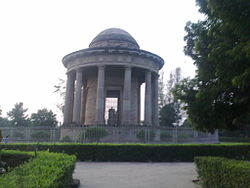Ghazipur | |
|---|---|
City | |
 The Tomb of Lord Cornwallis, Governor-General of Bengal | |
| Nickname: City of Martyrs | |
| Coordinates: 25°35′N 83°34′E / 25.58°N 83.57°E | |
| Country | |
| State | Uttar Pradesh |
| District | Ghazipur |
| Settled | 350–400 BCE |
| Founded | 1330 |
| Officially Incorporated | 1820 |
| Government | |
| • Type | Municipal Council |
| • Body | Ghazipur Municipal Council |
| • Chairperson | Sarita Agarwal |
| Area | |
• Total | 36.6 km2 (14.1 sq mi) |
| Population (2011) | |
• Total | 110,587[1] |
| • Rank | 391 |
| • Sex ratio | 902 ♀/1,000♂ |
| Demonym | Ghazipuria |
| Languages | |
| • Official | Hindi & Urdu |
| • Regional | Bhojpuri |
| Time zone | UTC+5:30 (IST) |
| PIN | 233001 |
| Telephone code | 91-548 |
| Vehicle registration | UP-61 |
| Website | www |
Ghazipur is a city in the state of Uttar Pradesh, India. Ghazipur city is the administrative headquarters of the Ghazipur district, one of the four districts that form the Varanasi division of Uttar Pradesh. It is located on the Ganges (Ganga) River near the border with Bihar state, about 40 miles (65 km) northeast of Varanasi (Benares). The city of Ghazipur also constitutes one of the seven distinct tehsils, or subdivisions, of the Ghazipur district.[2][3]
Ghazipur is well known for its opium factory, established by the British East India Company in 1820 and still the biggest legal opium factory in the world, producing the drug for the global pharmaceutical industry.[4] Ghazipur lies close to the Uttar Pradesh-Bihar border, about 80 km (50 mi) east of Varanasi.[5]
- ^ "2011 census of India".
- ^ "Tehsil | District Ghazipur, Government of Uttar Pradesh | India,"
- ^ "Ghazipur, a city established during Tughlaqs".
- ^ Paxman, Jeremy (2011). "Chapter 3". Empire:What Ruling the World Did to the British. London: Penguin Books.
- ^ "Sir Sayed Ahmad Khan|Books".

